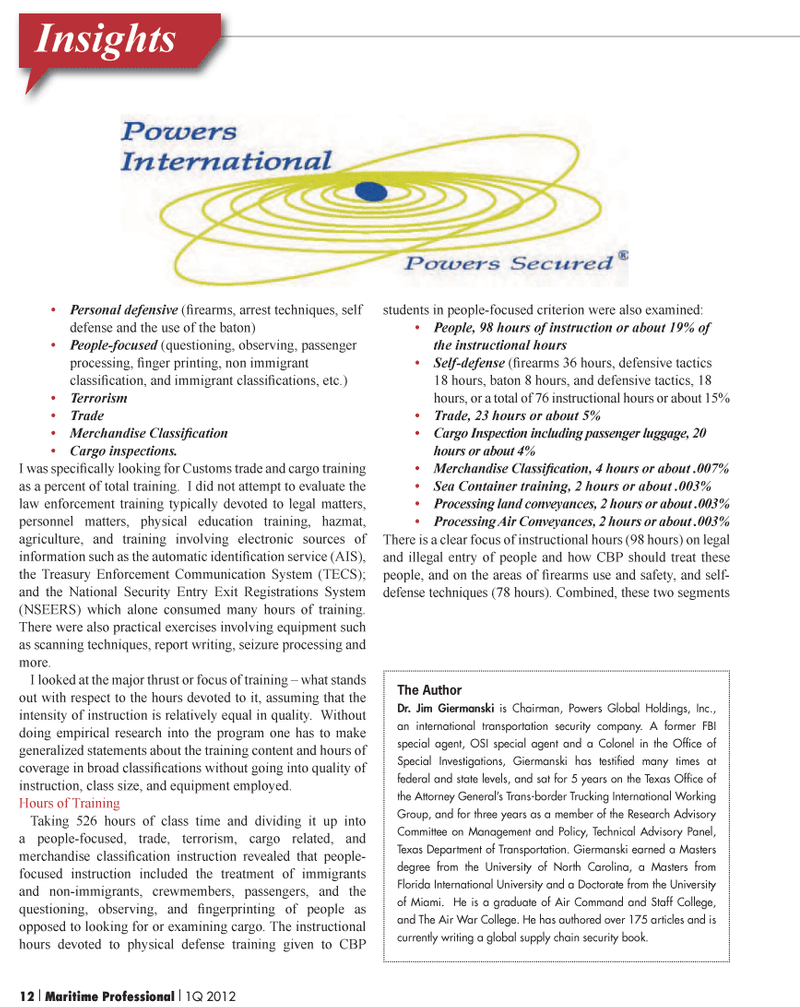
Page 12: of Maritime Logistics Professional Magazine (Q1 2012)
Training & Maritime Security
Read this page in Pdf, Flash or Html5 edition of Q1 2012 Maritime Logistics Professional Magazine
?Personal defensive (Þ rearms, arrest techniques, self defense and the use of the baton) ?People-focused (questioning, observing, passengerprocessing, Þ nger printing, non immigrant classi Þ cation, and immigrant classi Þ cations, etc.) ?Terrorism ?Trade ?Merchandise Classi Þ cation ?Cargo inspections.Iwas speci Þ cally looking for Customs trade and cargo training as a percent of total training. I did not attempt to evaluate the law enforcement training typically devoted to legal matters, personnel matters, physical education training, hazmat, agriculture, and training involving electronic sources of information such as the automatic identi Þ cation service (AIS), the Treasury Enforcement Communication System (TECS); and the National Security Entry Exit Registrations System (NSEERS) which alone consumed many hours of training. There were also practical exercises involving equipment such as scanning techniques, report writing, seizure processing and more.I looked at the major thrust or focus of training ? what stands out with respect to the hours devoted to it, assuming that the intensity of instruction is relatively equal in quality. Without doing empirical research into the program one has to make generalized statements about the training content and hours of coverage in broad classi Þ cations without going into quality of instruction, class size, and equipment employed. Hours of Training Taking 526 hours of class time and dividing it up into apeople-focused, trade, terrorism, cargo related, and merchandise classi Þ cation instruction revealed that people- focused instruction included the treatment of immigrants and non-immigrants, crewmembers, passengers, and the questioning, observing, and Þ ngerprinting of people as opposed to looking for or examining cargo. The instructional hours devoted to physical defense training given to CBP students in people-focused criterion were also examined: ?People, 98 hours of instruction or about 19% of the instructional hours?Self-defense (Þ rearms 36 hours, defensive tactics 18 hours, baton 8 hours, and defensive tactics, 18 hours, or a total of 76 instructional hours or about 15% ?Trade, 23 hours or about 5% ? Cargo Inspection including passenger luggage, 20 hours or about 4%? Merchandise Classi Þ cation, 4 hours or about .007% ?Sea Container training, 2 hours or about .003%? Processing land conveyances, 2 hours or about .003% ? Processing Air Conveyances, 2 hours or about .003% There is a clear focus of instructional hours (98 hours) on legal and illegal entry of people and how CBP should treat these people, and on the areas of Þ rearms use and safety, and self- defense techniques (78 hours). Combined, these two segments The AuthorDr. Jim Giermanski is Chairman, Powers Global Holdings, Inc., an international transportation security company. A former FBI special agent, OSI special agent and a Colonel in the Of? ce of Special Investigations, Giermanski has testi? ed many times at federal and state levels, and sat for 5 years on the Texas Of? ce of the Attorney Generals Trans-border Trucking International Working Group, and for three years as a member of the Research Advisory Committee on Management and Policy, Technical Advisory Panel, Texas Department of Transportation. Giermanski earned a Masters degree from the University of North Carolina, a Masters from Florida International University and a Doctorate from the University of Miami. He is a graduate of Air Command and Staff College, and The Air War College. He has authored over 175 articles and is currently writing a global supply chain security book.Insights12 I Maritime Professional I1Q 2012

 11
11

 13
13
